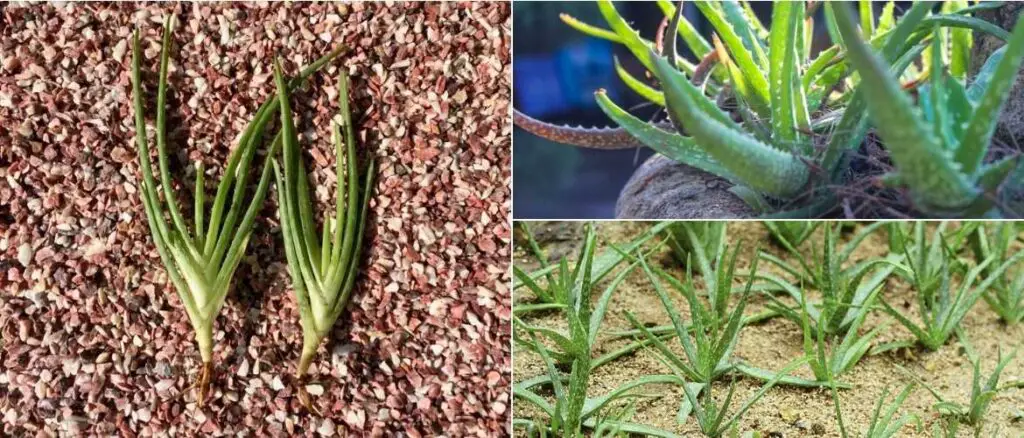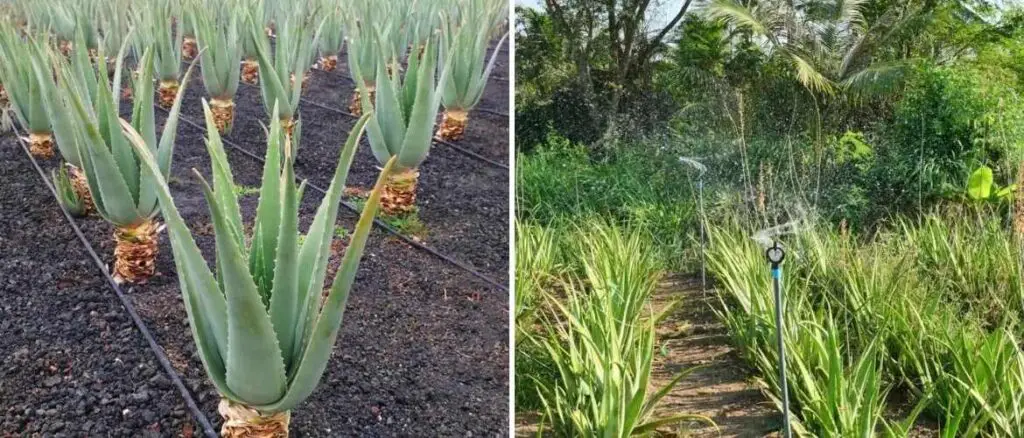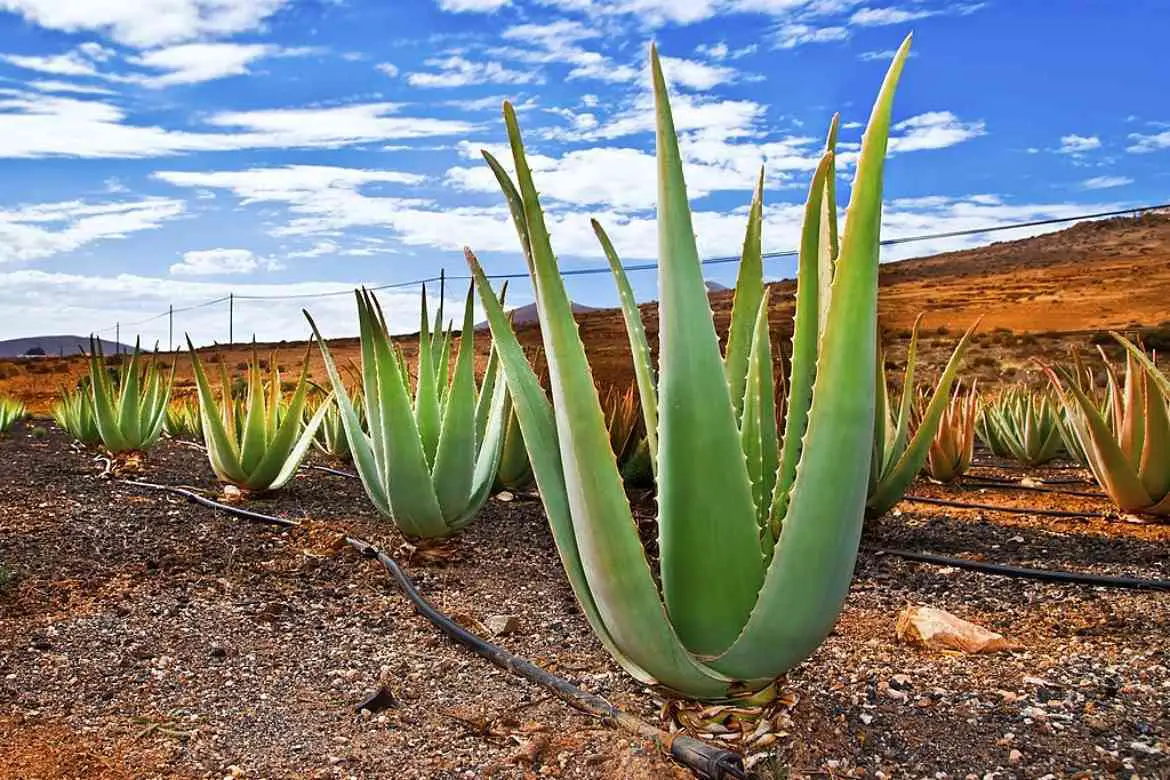Table of Contents
Introduction to aloe vera
Aloe vera, a succulent perennial plant that resists drought, is well-known for its therapeutic properties.
Several beneficial effects of Aloe vera have been documented, such as immunomodulation, wound and burn healing, hypoglycemia, anticancer, gastro-protective, antifungal, and anti-inflammatory properties.
Aloe vera has been used for a variety of commercial purposes because of its beneficial therapeutic properties.
Taxonomy of Aloe vera
Kingdom – Plantae
Order – Asparagales
Division – Spermatophyta
Subdivision – Angiospermae
Class – Monocotyledoneae
Family – Liliaceae
Genus – Aloe
Species – barbadensis Mill
Other names of Aloe vera
Arabic – Sibr Chinese – Lu Hui
Persian – Sibr Cuban – Sabilla
Urdu – Ailwa Dutch – Aloe
Hindi – Kumari French – Aloes
Sanskrit – Ghritra kumari German – Aloe
Kannada – Karilola Greek – Aloi
Telugu – Kalabanda Haiti – Laloi
Tamil – Kattalai Italian – Aloe
Gujarati – Eliyo Japanese – Rokai
Kashmiri – Musabbar Korean – Nohwa
Marathi – Korphad Russian – Aloe, Aloi, Sabur
Oriya – Musaboro Thai – Wan hang Jo
Punjabi – Musabbar Vietnam – Lohoi
Assamese – Musabhar
Morphology of aloe vera
Taste : Bitter
Odour : None
Size & Shape : Plant growing to 60-100cm in lance-shaped with elongated.
Strands Colour : Leaves are green to grey- green flower.
Flower : Yellow tubular in 25-35cm in a slender loose staments.
Root : Root fibbers that can reach 30-40 cm in length
Market and Government initiative for aloe vera farming
Based on the report made by IMARC, the compound annual growth rate – CAGR of global aloe vera market is predicted to rise by the rate of 7.70% for the year of 2021-2026. USA is the global leader in aloe vera production.
As reported by NMPB – National medicinal plant board (statistics from 2015-2016), Uttar Pradesh was the leading state in India with 512 hectares of aloe vera farming. wwhile, Manipur being the 2nd ranking state and Rajasthan being the 3rd ranking state in terms of aloe vera cultivation.
Manipur, Kerala, Mizoram, Himachal Pradesh, Telangana, Rajasthan, Uttar Pradesh, Jammu and Kashmir, Haryana, Maharashtra and Karnataka are the states in India where NMPB has recorded aloe vera cultivation.

Medicinal and aromatic plants (MAPs) are now not just playing an important part in Indian traditional medicine market but also experiencing a worldwide demand as more and more research and studies are proving their credibility. Hence, aloe vera cultivation proves to be one of the profitable agribusinesses.
NAM program initiated by NMPB focus on shifting the dependence of harvesting the MAPs from forest area to planned cultivation with good agricultural practices. A total of 140 priority medicinal plant species are identified, out of which 95 species have been finalized by NMPB for subsidy schemes . Aloe vera being one of them (with eligibility of 30% subsidy).
Click Here to get the details of the nodal and controlling offices in your respective state.
Guide to aloe vera farming
In the following section, we will present the general good practices for aloe vera farming. Please keep in mind, the some methods and procedures ( such as soil enrichment and spacing ) might vary depending on the terrain and the soil composition. However, in most cases, the methods presented in this section can be applied to any aloe vera farm.
Commercial varieties of aloe vera for farming
- Aloe barbedensis
- Aloe chinensis
- Aloe perfoliata
- Aloe vulgaris
- Aloe indica
- Aloe littoralis
- Aloe abyssinica
- IC111271
- IC111269
- IC111280
- AL-1
Soil for aloe vera farming
- Aloe vera grows best in hot, humid climates with high rainfall.
- All kinds of soils can be used, but well-drained soil with high organic matter is ideal.
- Aloe vera grows better on medium fertile, heavy soils, such as black cotton soil. However, most aloe vera species can grow in sandy soil.
- Well-drained high land should be selected as aloe vera is highly sensitive to water stagnation.
- In bright sunlight, it grows well. However, shady conditions result in disease infestation.
- The plant grows best when supplied with an excess of 50 cm of rain annually, in nitrogen-rich, alkaline soil.
- Soil nitrogen should ideally be maintained at 0.40%–0.50%.
- The aloe vera plant has ability to withstand high pH soil and high concentration of sodium and potassium.
- Loam to coarse sandy loam soil with a pH level ranging up to 8.5 can also be used for aloe vera farming (advisable)
Climate for aloe vera farming
- The Aloe vera plant has wide adaptability and can grow in a variety of climates.
- The plant grows equally well in humid and dry climates. It is, however, intolerant of extreme cold temperatures.
- The aloe vera plant can grow on dry sandy soil and even flourish in locations with lo annual rain fall of 50 to 300 mm.
- The plant requires protection against frost and low temperatures during the winter.
Land Preparation for aloe vera farming
- To make the soil weed-free and crumbly, about 2-3 ploughings and ladderings are done. This activity is followed by land leveling. Depending on the nature of the soil, the number of ploughings can be increased or reduced.
- Drainages can be made along the slope of the farm to prevent water stagnation. The spacing of the drainages can be 15-20 feet.
- The root system of the aloe vera plant does not go below 20-30 cm. Hence, tillage/ ploughing should not be done too deep.
- During the last plough, farm yard manure (FYM) can be added – 10-15 tonnes/ha.
- The plot can also be irrigated if necessary.
Spacing between plants for aloe vera farming
- The spacing guidelines provided by National Mission on Medicinal plants – NMMP for aloe vera is 60cm x 45cm (1.5 x 2 feet). This amounts to a total of 36500 number of aloe vera plants in 1 hectare aloe vera farm. ( or 14550 in 1 acre aloe vera farm)
- Some people also suggest a spacing of 60cm x 60cm (2 x 2 feet). This spacing scheme will yield approximately 25000 aloe vera plants in 1 hectare farm.
- A spacing scheme of 40cm x 45cm or 60cm x 30cm can also be followed. This will yield approximately 55000 aloe vera plants in 1 hectare farm.
Planting material and propagation for aloe vera farming

- There are 2 types of planting materials which can be used for aloe vera planting : suckers (Also known as root suckers) or rhizome cuttings.
- It is advisable to choose 3-4 months old suckers. These suckers should be 20-25 cm in length and preferably have 4-5 leaves.
- The root suckers are carefully extracted from the bottom of the parent plant (without damaging the parent plant).
- The propagation of aloe vera plant can also be done with root cuttings. After the harvest of aloe vera plants, roots of the plant is extracted and cut into pieces of 5-6 cm in length. The cutting should have atleast 2-3 nodes on it.
- These roots are again planted on specially prepared sand beds and are ready to be planted as a new plant after sprouting.
- Root suckers or rhizome cuttings can be planted in a pit which is 15 cm deep.
- make sure to firmly press the soil around the plant after planting the sucker and avoid any sloping which can result in water stagnation.
Manuring and application of Plant Nutrients for aloe vera farming
- As presented earlier, 10-15 tonnes / hectare farm yard manure (FYM) is applied at the time of soil preparation.
- Same quantity of FYM can be applied in the subsequent years also.
- It is advisable to add 70 kg of Phosphorus pentoxide (P2O5), 35 kg of nitrogen (N) and 70 kg of Potassium oxide (K2O) per hectare, at the time of last ploughing. ( This ratio can also be varied to 50:50:50 kg / hectare depending on the soil condition).
- To prevent the plants from termites, 400 kg of neem cake per hectare can be added to the mix.
- The application of 40 kg of Nitrogen per hectare as top dressing in the month of September – October can also be practiced. However, all these practices can be modified and tweaked based on the soil and climate conditions. (Ideal percentage of nitrogen in soil is 0.40%–0.50%).
Irrigation for aloe vera farming

- Even though aloe vera is drought resistant, good irrigation practices can boost good growth of the crop.
- Aloe vera can be farmed in both rainfed and irrigation models.
- A light irrigation is recommended just after planting of the suckers. Some experts argue against the practice of immediate irrigation after planting because of the fear of water logging. Hence, if you plan to irrigate right after planting of suckers, make sure to avoid any kind of water stagnation.
- 4-6 irrigation per year is good (this again depends on the climate, rain and geography).
- It is advisable to irrigate the crop at the time of summer and drought for better crop yield.
- It is also advisable to irrigate after picking of leaves.
- Need of digging a bore well varies from case to case
Maintenance and plant protection for aloe vera farming
- After almost 40 days of planting, manual weeding can be done.
- Earthing up is advisable at the time of applying ktop dressing fertilizers.
- 2-3 manual weeding per year is a good practice.
- Appropriate fungicides must be applied to prevent leafspot disease caused by fungus
- Neem oil (10,000 ppm) 2-3 ml per liter or tobacco extractant 20 ml per liter can be applied for crop protection.
- Reduce the frequency of watering the crop in the months or winter as aloe vera plants become dormant in this season.
- A land with ample exposure of sunlight is prefered for aloe vera farming. In case the leaves of aloe vera grow flat, increase the sunlight exposure ( for indoor / enclosed cultivation).
- Decrease the exposure to sunlight incase the the leaves start turning brown.
- If the leaves of aloe vera are curling or thinning, increase the water supply.
- Excess water supply can also prove to be harmful to aloe vera plant. As, excess water can result in yellowing or melting or shedding of leaves.
Harvesting and yield of aloe vera in aloe vera farming
- Though harvesting of aloe vera crop can start after about 8 months of planting, the best crop yield starts coming after 2 years of aloe vera farming. This yield will be consistent for 4-5 years.
- Harvesting of aloe vera is labor intensive as it is done manually and specail care is taken while cutting the leaves as no juice or gel should be wasted.
- Harvesting of ale vera leaves is done by pulling the leaves of the plant away from it and cutting it using a sharp knife. Dull knife will not give a clean cut and result in damaging the rind and wastage of gel. (3-4 leaves are harvested per plant).
- You should not harvest leaves with tip necrosis, since these provide entry points for contamination by microorganisms.
- The best advisable harvest season for aloe vera leaves is October – November ( In case harvesting is done once a year).
- The best advisable harvest season for aloe vera flower is December – January.
- When the crop has matured ( generally after 2 years), harvesting can be done 2-3 times per year.
- Yearly yield of aloe vera leaves can be around 10 tons per hectare and aloe vera leaves can be around 4 quintals per hectare.
Government subsidy for Aloe vera farming
According to Prioritised list of Medicinal Plants for cultivation, aloe vera comes under the medicinal plants which are eligible for 30% subsidy. National Mission on Medicinal Plants or now known as National Medicinal Plants Board – NMPB (merged with National AYUSH Mission – NAM in 2015-16), facilitates with the subsidy application process. (It also has roles like drawing up policies and strategies for conservation, proper harvesting, cost-effective cultivation, research and development, processing, marketing of raw material in order to promote and develop this sector.)
Based on the report released by the national medical plant board in 2016-17, the estimated cost of farming aloe vera per is 24889.70 rupees per hectare or 20570.00 rupees per acre. (The base cost will be increased by 10% every subsequent year).
Apart from the subsidy on aloe vera farming in India, NMPB has also released details of subsidy on other agrobusinesses such as subsidy on nursery setup for aloe vera, subsidy on post-harvest management of aloe vera, subsidy on processing of aloe vera.
Assistance and subsidy for aloe vera nursery and aloe vera farming
| Programme | Estimated Cost | Admissible Assistance / Subsidy |
|---|---|---|
| 1. Nursery | ||
| Production of planting material | ||
| a) Public sector | ||
| i) Model nursery ( 4 ha.) | 25 Lakh INR | Maximum 25 lakh INR |
| ii) Small nursery (1 ha.) | 6.25 Lakh INR | Maximum 6.25 lakh INR |
| b) Private sector | ||
| i) Model nursery ( 4 ha.) | 25 Lakh INR | 50% of cost limited to 12.5 lakh INR |
| ii) Small nursery (1 ha.) | 6.25 Lakh INR | 50% of cost limited to 3.125 lakh INR |
| 2. Cultivation | ||
| Aloe vera cultivation | As per the estimates by the government for current year | 30% of total cost of cultivation |
Assistance and subsidy for aloe vera post harvest management
| Programme | Estimated Cost | Admissible Assistance / Subsidy |
|---|---|---|
| Drying shed | 10 lakh INR | 100% subsidy for government / semi-government / public sector 50% subsidy for SHGs / Cooperatives / Private sector |
| Storage godowns | 10 lakh INR | 100% subsidy for government / semi-government / public sector 50% subsidy for SHGs / Cooperatives / Private sector |
Assistance and subsidy for aloe vera processing
| Programme | Estimated Cost | Admissible Assistance / Subsidy |
|---|---|---|
| Processing unit | 4 crore INR | 100% subsidy for government / semi-government / public sector / SHGs / Cooperatives / Private sector Limited to 4 crore INR / Unit |
| Marketing infrastructure | 10 lakh INR for rural collection center | 100% subsidy for government / semi-government / public sector 50% subsidy for SHGs / Cooperatives / Private sector |
| 2 crore INR for district collection center | 100% subsidy for government / semi-government / public sector 50% subsidy for SHGs / Cooperatives / Private sector | |
| Organic / GAP certification | 5 lakh INR / 50 Ha. | Assistance / subsidy upto 50% of the cost limited to 10000 INR / ha. Minimum area of 4 ha is required. The subsidy amount will be given spreading over a period of 3 years for GAP farming. For GAP certification, 5 lakh INR for 50 ha. will be provided |
| Demonstration plots | _ | Project based depending upon species cultivated and infrastructure created limited to Rs. 10.00 lakhs / plot of minimum 2 acres |
| Setting up of seed/ germ plasm centres | _ | Rs. 25 lakhs/ centre |


